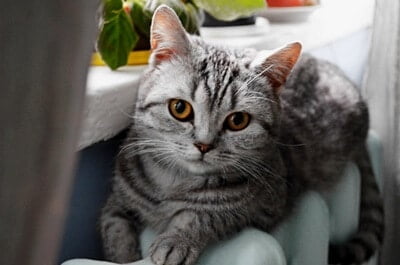Cats hate living in a cold house. More worryingly, a cold cat could develop mild hypothermia. A feline with a low body temperature will display a range of symptoms that will alert you if there’s a problem.
Your cat won’t be too cold, provided that your home’s ambient temperature stays above 70 degrees Fahrenheit. Your cat’s ideal body temperature is 100.5 to 102.5 degrees Fahrenheit or 38.1 to 39.2 degrees Celsius. If your home is particularly cold, you’ll need to keep your cat warm with a thick blanket and a hot water bottle.
Monitor your cat’s behavior and, if necessary, take its temperature to ensure that it’s optimal. Keep your cat away from draughts and chilly areas of the home that could lower its temperature further.
Is My House Too Cold for a Cat?
As mentioned, a cat’s body temperature should run between 100.5-102.5 degrees Fahrenheit. This is a little warmer than a human’s temperature, which is at around 97 degrees Fahrenheit.
There will always be body temperature fluctuations. As Science explains, a cat will automatically become slightly cooler while sleeping. This won’t be enough to place a cat in any danger, though.
The ideal room temperature for cats is 70 degrees Fahrenheit, which is the average temperature of a home during the winter season. This will enable your cat to maintain its optimum body temperature.
This is based on the average cat. Longhaired cats will retain warmth easier as their fur will offer additional protection from the elements. Obviously, a hairless cat, such as a Sphinx, will feel the cold significantly more.
If the room temperature drops below 70 degrees Fahrenheit, mild hypothermia becomes a risk. Adult cats are hardy and skilled at moderating their body temperature, but you need to be mindful of the risk.
Hypothermia in Cats
Hypothermia is a condition that sees the body lose heat faster than it can be replaced. Hypothermia in healthy cats due to low room temperature is rare.
According to the Journal of Veterinary Emergency and Critical Care, a cat is more likely to develop hypothermia during surgery because its heart will slow down, reducing blood flow.
Feline hypothermia unfolds in three stages, with differing symptoms. The body temperature of your cat dictates its level of hypothermia.
| Cat’s Body Temperature | Symptoms |
|---|---|
| Mild Hypothermia (90-99 degrees) | Muscular weakness, shivering, lack of concentration |
| Moderate Hypothermia (82-89 degrees) | Stiff muscles, reduced heart rate, shallow breathing |
| Severe Hypothermia (below 81 degrees) | Dilated eyes, panting, weak heart, loss of consciousness |
It is unlikely that room temperature will see a cat drop below mild hypothermia. Anything more severe suggests a medical issue. Mild hypothermia can be resolved with blankets and hot water bottles. A vet will need to urgently address cases of moderate and severe hypothermia.
How to Tell When A Cat is Cold
Not all cats shiver when they’re cold. No matter what the ambient temperature is, a cat should have the option to warm up. When the cat feels comfortable, it will move to somewhere cooler. Signs that your cat is cold include:
- Sleeping in a ball
- Sleeping alongside another cat to share body heat
- Hunching and puffing up its fur
- Sitting beside heat sources
- Seeking affection to derive warmth from your body
If you ignore these warning signs, your cat may develop mild hypothermia. You can check if your cat is cold by touching its ears, tail, and paw pads. These are the parts of a cat’s anatomy where heat escapes.

Taking a Cat’s Temperature
These readings will be accurate, but it is an invasive process. Many cats will do their utmost to prevent you from taking their temperature. If you decide to proceed, you can do so in one of two ways:
Rectal Thermometers
Rectal thermometers are an accurate way of measuring a cat’s temperature. There are two options: digital or mercury.
Digital thermometers are recommended as they yield faster results and are less invasive. Mercury thermometers are made of glass, so proceed with caution. To take your cat’s temperature rectally, follow these steps:
- Play with the cat as you want it to be tired and docile
- Restrain the cat, ideally by wrapping it in a soft towel
- Calm the cat with petting and treats
- Ensure the thermometer reads below 96 degrees Fahrenheit
- If using a mercury thermometer, shake it
- Apply lubricant to the tip of the thermometer (Vaseline is fine)
- Gently insert the thermometer around an inch into the cat’s rectum
- If using a digital thermometer, wait for a beep
- If using a mercury thermometer, leave it in position for two minutes
- Remove the thermometer and let your cat free
The results of the thermometer should read above 100.5 degrees Fahrenheit. If this is not the case, your cat is too cold. Focus on providing your cat with warmth in whatever way you can.
Ear Thermometers
Ear thermometers are less intrusive, but they’re more expensive. Also, not all cats are happy with intrusion into the ear.
If you wish to use an ear thermometer, check how your cat will respond. Tickle or stroke your cat around the ear. If it bites, scratches, or flees, this will not work. If your cat permits you to touch its ears, take these steps:
- Calm the cat down with petting
- Pick the cat up, holding it tightly against your body
- Restrain the cat with a towel as it will start to squirm
- Hold the thermometer horizontally and insert it into the ear canal
- All ear thermometers are digital, so wait for a beep
Once this occurs, you can release the cat and assess the reading. As with a rectal temperature, anything below 100.5 degrees Fahrenheit is a concern.
Why Is My Cat So Cold?
Ensure that your cat is not sitting beside a draught. If the window is cracked or permanently open, this will make your cat feel cold. Your cat may also be feeling a chill from an air vent.
Another common reason for low body temperatures in cats is wet fur. Many cats dislike water because it takes so long for them to warm up.
Cats that roam outside may also experience a prolonged low body temperature. Cats often find shelter from extreme weather, such as heavy rain or snow. This is not always possible, though.

If your cat comes home wet and cold, focus on increasing its body temperature. This is important if the cat stayed out overnight. Medical explanations for a cat to be cold, even if the room temperature tops 70 degrees Fahrenheit, include:
- Respiratory infections
- Lack of food intake
- Allergies
- Consumption of toxins
- Shock due to a fall or road traffic accident
- Side-effects of anesthesia or medication
If your cat remains cold for 24 hours, or displays other signs of ill health, seek advice from a vet.
How to Warm Up a Cat
Apply central heating if you have it or use portable heaters. Just ensure that these are cat-safe as a curious feline may burn itself or create a fire hazard.
This will be enough to aid a slightly chilled cat. In many cases, you will need to warm up your cat directly. Blankets in the cat’s bed are the easiest way to achieve this goal. Few cats can resist warm, soft materials. Other ways to keep a cat warm in the home include:
- Hot water bottles
- Heated blankets and mats. Keep them at a low temperature to avoid burns
- Double-glazed windows and insulated walls
Physical exercise can also increase your cat’s body temperature. Reach for a favorite toy and encourage play. The more your cat moves, the more its circulation will improve. This will result in a temporarily higher body temperature.
You could treat this as an opportunity to cuddle your cat. Some cats will seize the opportunity to enjoy such physical closeness. Of course, this is not a sustainable long-term option.
If your home maintains a temperature of 70 degrees Fahrenheit, your cat won’t be too cold. If the temperature drops below this level, your cat is at risk of mild hypothermia.

